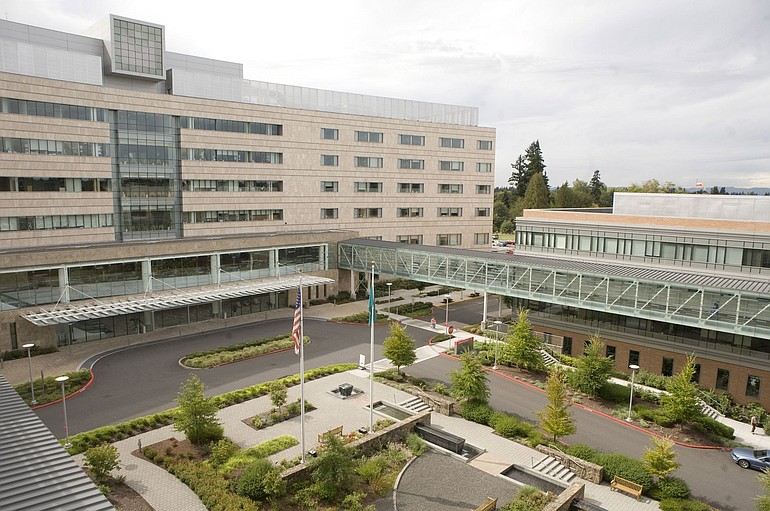Portland-based Legacy Health System overspent its budget to build Clark County’s Legacy Salmon Creek Medical Center by 24 percent, ballooning the cost of the hospital from an originally approved $161.9 million to $200.4 million, documents obtained by The Columbian show.
The $38.5 million cost overrun is under review by the Washington State Department of Health, which approved construction of the hospital more than eight years ago. Paid for entirely out of Legacy’s cash reserves, the Salmon Creek facility finished opening its 220 beds in October 2009. Overruns are fairly typical in large construction projects.
However, because the hospital’s capital costs exceeded 12 percent of the originally approved amount, Legacy must get the OK from state health regulators to change its original building application to reflect the increase. It also must explain the cost overrun. And, in a related move, Legacy is seeking to bolster its ability to borrow money by using the Salmon Creek hospital as collateral — prohibited under current state licensing.
Legacy officials said the cost overrun has had no effect on the hospital’s financial operation or the level of service it provides patients. Diane Buelt, director of clinical and support service at Legacy Salmon Creek Medical Center, said the overrun is understandable when you consider the high cost of construction materials at the time and when you compare it to other hospital construction projects.
“We had a 24 percent cost overrun,” she said. “Honestly, that’s very good cost containment.”
Karen Nidermayer, an analyst for the state’s health department, said it would be unusual to deny Legacy’s request to accept the cost overrun since the hospital has already been built. Nidermayer said it’s typical for a new hospital project that takes a while to finish to experience cost increases. What health regulators are focusing on is “making sure the project is still financially feasible” and that Legacy “can afford to pay for those increases in cost.”
A decision is expected no later than Oct. 12. Legacy would have the opportunity to appeal a decision it disagrees with.
The Salmon Creek hospital was proposed in the early part of the decade amid fierce community debate over whether it was needed. Backers argued it would be a victory for competition and geographic convenience in an otherwise one-hospital town dominated by Vancouver-based Southwest Washington Medical Center. Opponents lobbed arguments against it, including the claim that a new hospital would duplicate already-available services.
In March 2002, Legacy won the right to build the project under the state’s “certificate of need” program, which evaluates whether facilities and services proposed by health care providers are needed within a given region.
Final approval of a certificate of need is important: Providers of medical insurance frown on hospitals that don’t have that official stamp, Nidermayer said. “Insurers can say, ‘I’m not reimbursing you for that service,’” if a hospital lacks final approval of its certificate of need, she said.
The approved budget for the Salmon Creek hospital’s build-out — $161.9 million — covered such costs as purchase of land, land improvements, construction costs, moveable equipment, fixed equipment, architect and engineer fees and state sales tax. The hospital was built in two phases. The first phase, which opened in August 2005, included 165 beds and a neonatal intensive care unit. The second phase opened in October 2009 with 55 beds.
Difficult to predict
This March, Legacy filed documents with state health regulators reporting the final cost of the hospital at $200.4 million. During the hospital’s two building phases the single biggest cost increase occurred in construction. Originally budgeted for $95.5 million, it jumped 33 percent to $126.8 million.
In documents filed with state health regulators, Jonathan Avery, chief administrative officer for Legacy Salmon Creek Medical Center, pinned the construction cost overrun on two issues: the rising cost of construction materials and the decision by Legacy to exclude the cost of completing phase two of the hospital’s construction from the original certificate of need.
The building of Legacy Salmon Creek “occurred during a time of soaring costs for construction materials both nationwide and in Washington state,” Avery wrote. “These increases were attributed to general inflationary pressure coupled with intense and increasing demand for construction materials in China and India — all of which was underscored by rapid increases in petroleum prices (used of course in the production, finishing and transport of other materials).”
Despite these pressures, the $95.5 million originally set aside for construction “increased only by 21 percent” to $115.1 million in the first phase of the project, Avery wrote. This “relatively modest increase in Phase 1 (21 percent of construction costs, but only 12.1 percent of total project costs) is reflective of the strong project management skills and expertise of LHS.”
Ultimately, the cost of construction for both phases of the project grew to a total of $126.8 million, driven partly by the fact that Legacy’s original certificate of need included only the construction cost of finishing the exterior of the second phase, not completing the full building, Avery wrote. Other second-phase costs, including architectural and equipment expenses, added millions of dollars to the project and helped push its final cost to more than $200 million.
Brian Willoughby, spokesman for Legacy Salmon Creek Medical Center, said the full cost of the hospital’s second phase wasn’t outlined early on partly because it was going to be built later when the capacity would be needed. Plus, based on the ample time state health regulators granted Legacy to finish the hospital, there were “many years where we didn’t have to identify what the build-out would be,” Willoughby said.
Adding to the uncertainty surrounding the costs of the second phase was the fact that the hospital wasn’t sure about the types of services it would provide based on future needs and demands. At that point, Willoughby said, trying to nail down the full costs of building out the hospital would have amounted to mere “guesswork.”
Other hospitals have experienced cost overruns, so the situation with the Salmon Creek facility is not unusual.
For example, the Puget Sound Business Journal reported that the cost of St. Anthony Hospital in Gig Harbor, which was originally projected at about $100 million, grew 35 percent to $135 million.
And in June state health regulators approved a request by Southwest Washington Medical Center to accept a cost overrun on a project to add 82 beds. That project, budgeted for $13.7 million increased 21 percent to $16.6 million.
Legacy’s spending isn’t the only issue being examined by state health regulators. As part of its request to accept the cost overrun, the nonprofit also is asking health regulators to remove a condition they placed on the project when they originally signed off on it.
That condition prohibited Legacy from borrowing money to build the Salmon Creek hospital. Since Legacy complied with that condition by using only cash reserves, the restriction should be removed, said Campbell Groner, senior vice president, chief legal officer and compliance officer for Legacy.
Removing the condition would enable Legacy to achieve another goal: adding Legacy Salmon Creek to its portfolio of Oregon hospitals that can be used as collateral in selling bonds, to fund equipment purchases and building renovations. Not being able to include Legacy Salmon Creek as an asset in debt offerings is hampering the nonprofit’s ability to win competitive interest rates and to provide the extra security investors are looking for these days, Groner said.
In a Jan. 4 letter to the state’s health department, Groner wrote that the prohibition “has become a source of problems in bond financings Legacy has undertaken for its Oregon facilities (financings which have nothing to do with Salmon Creek).”
Groner wrote that the chances that Legacy Salmon Creek would end up on the hook if its nonprofit parent defaulted on a debt payment are “extremely unlikely” given Legacy’s “financial strength and significant reserves.”




